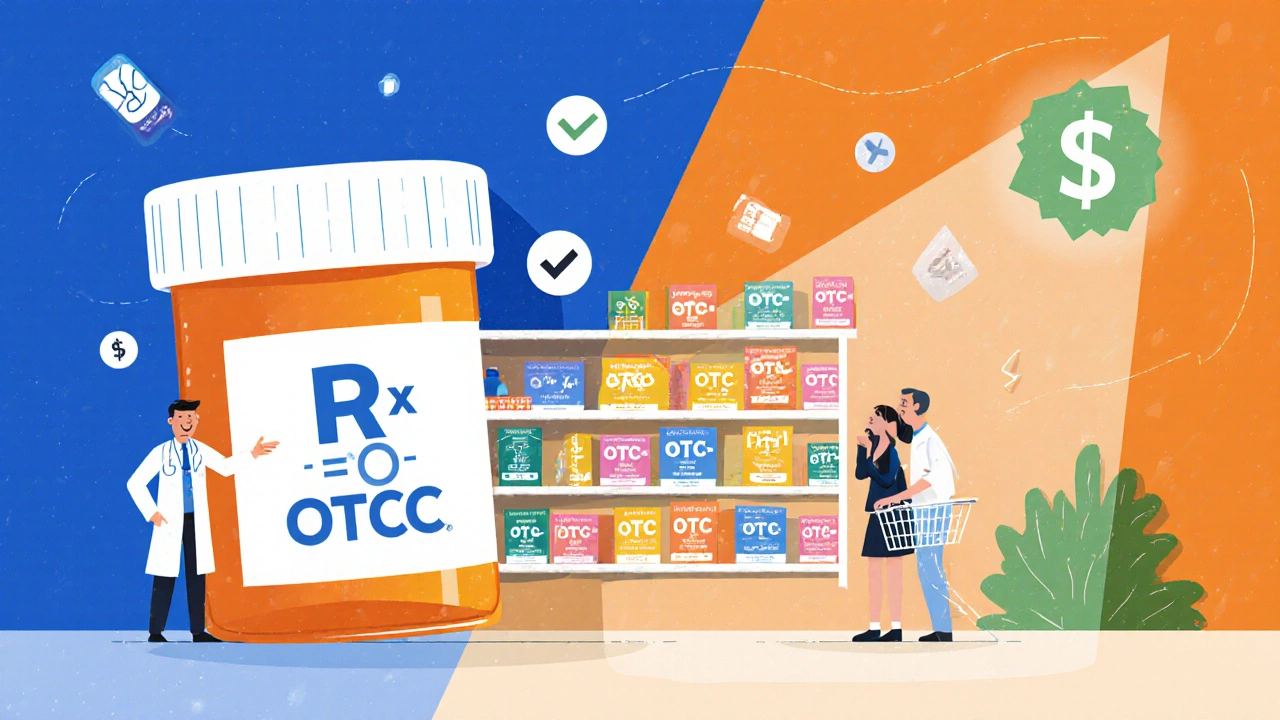
Medication Interaction Checker
Check for potential interactions between your current medications and OTC products before purchasing. This tool helps identify risks based on common medications discussed in the Rx-to-OTC article.
Enter your medications and select an OTC product to check for potential interactions.
Ever wondered why you can now buy ibuprofen at the supermarket instead of a doctor's office? That jump from a prescribed pill to an over‑the‑counter (OTC) product is called a Rx-to-OTC switch. While the move promises convenience and lower costs, it also shifts the responsibility for safe use onto you, the consumer. Below you’ll learn what the switch really means, which pitfalls to watch out for, and a simple three‑step routine to keep yourself out of trouble.
What a Rx-to-OTC Switch Actually Is
Rx-to-OTC switch is a regulatory process where a drug that once required a prescriber's approval becomes available without a prescription. The U.S. Food and Drug Administration (FDA) only approves a switch after reviewing data that shows the medication can be used safely by people who self‑diagnose and follow label directions.
Typical criteria include:
- The condition can be identified by a lay person (e.g., occasional heartburn, minor aches).
- Label instructions are clear enough for anyone to follow.
- The drug has a wide safety margin, meaning accidental misuse is unlikely to cause serious harm.
Why Manufacturers Push for Switches
Switches aren’t just about convenience; they have a measurable economic impact. The Consumer Healthcare Products Association estimates that the U.S. saves roughly $102 billion each year in avoided doctor visits and prescription fills. For patients, the price drop is dramatic-ibuprofen went from $30‑$40 per month as a prescription in 1984 to under $10 in an OTC bottle the same year.
Beyond cost, broader access can speed up symptom relief. A migraine sufferer doesn’t need to schedule an appointment to grab a triptan that has already been approved for OTC use.
Safety Risks That Come With the Freedom
When a drug sheds its prescription label, the safety net of a clinician’s guidance disappears. Research consistently flags three major hazards:
- Self‑diagnosis errors: People may mistake a serious condition for a minor one and take the OTC product when they actually need a prescription.
- Drug‑drug interactions: OTC meds often contain the same active ingredients as prescription drugs. Double‑dosing acetaminophen, for example, can lead to liver toxicity.
- Population‑wide exposure: Children, seniors, and those with chronic illnesses are more likely to experience adverse effects because they process drugs differently.
Studies from PubMed (2023) show that inappropriate OTC use is linked to excess blood pressure spikes when decongestants meet MAO inhibitors, and to acute kidney injury when NSAIDs are taken without monitoring.
Who Is Most at Risk?
Not everyone faces the same level of danger. The American Geriatrics Society’s Beers Criteria lists about 30 OTC products that pose heightened risk for adults over 65-diphenhydramine (Benadryl) can cause confusion and falls, while NSAIDs raise the chance of gastrointestinal bleeding by up to fourfold.
Other vulnerable groups include:
- Very young children, whose bodies can’t metabolize certain antihistamines.
- People with chronic kidney or liver disease, who can’t clear NSAIDs efficiently.
- Patients on multiple prescription meds (polypharmacy), where an unnoticed overlap with an OTC drug can trigger dangerous interactions.
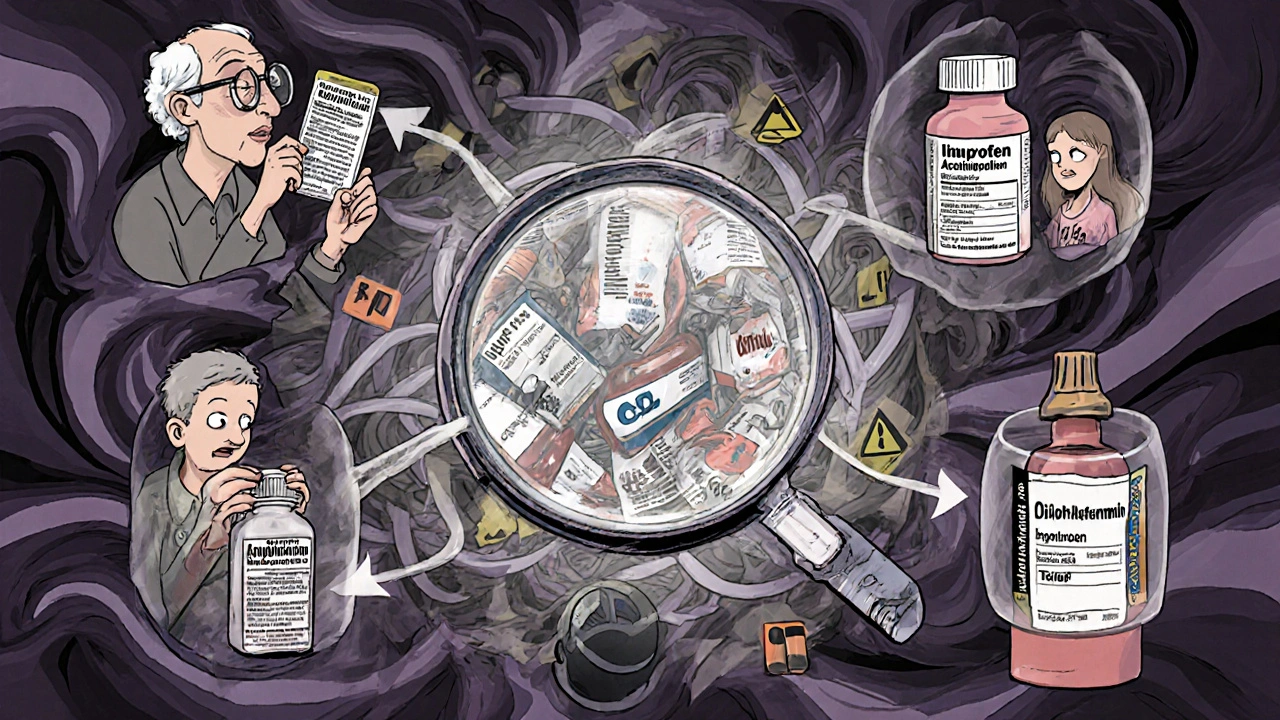
Three‑Step Safety Checklist for Every OTC Purchase
To protect yourself, follow this quick verification routine before you pop the lid:
- Read the "Warnings" section: Look for contraindications that match your health conditions-e.g., "Do not use if you are taking blood‑pressure medication" for certain decongestants.
- Cross‑check active ingredients: List every medication you’re currently taking, then match each ingredient. Pay special attention to acetaminophen, ibuprofen, and antihistamines, which appear in many products.
- Ask a pharmacist: Even a brief chat can uncover hidden interactions. Pharmacists are trained to spot red flags, especially when you’re on three or more drugs.
Older adults should also consider using a medication‑tracking app that alerts them when two products share the same ingredient.
The Label Is Your First Line of Defense
The FDA’s "Drug Facts" label format, mandatory since 1999, breaks information into six sections: active ingredients, purpose, uses, warnings, inactive ingredients, and directions. Studies show that only about one‑third of shoppers read the full label, yet those who do are far less likely to experience accidental overdose.
Key things to watch for:
- Maximum daily dose: Never exceed the total amount listed across all products.
- Age restrictions: Some nasal sprays are labeled for ages 12+ only.
- Storage requirements: Certain antihistamines degrade if stored in a hot car.
Pharmacist Interaction-Why It Matters
Community pharmacies see roughly 68 % of OTC buyers, but only 32 % of those buyers read the label thoroughly. When pharmacists proactively ask about existing conditions and other meds, adverse events drop dramatically. Unfortunately, a 2023 study in Bangalore found that while 85 % of patients felt the pharmacist’s advice was sufficient, the pharmacist often omitted questions about allergies or comorbidities.
Ask your pharmacist these three quick questions:
- Will this product interact with any of my prescriptions?
- Are there any health conditions that make this unsafe for me?
- What signs should prompt me to stop using it and call a doctor?
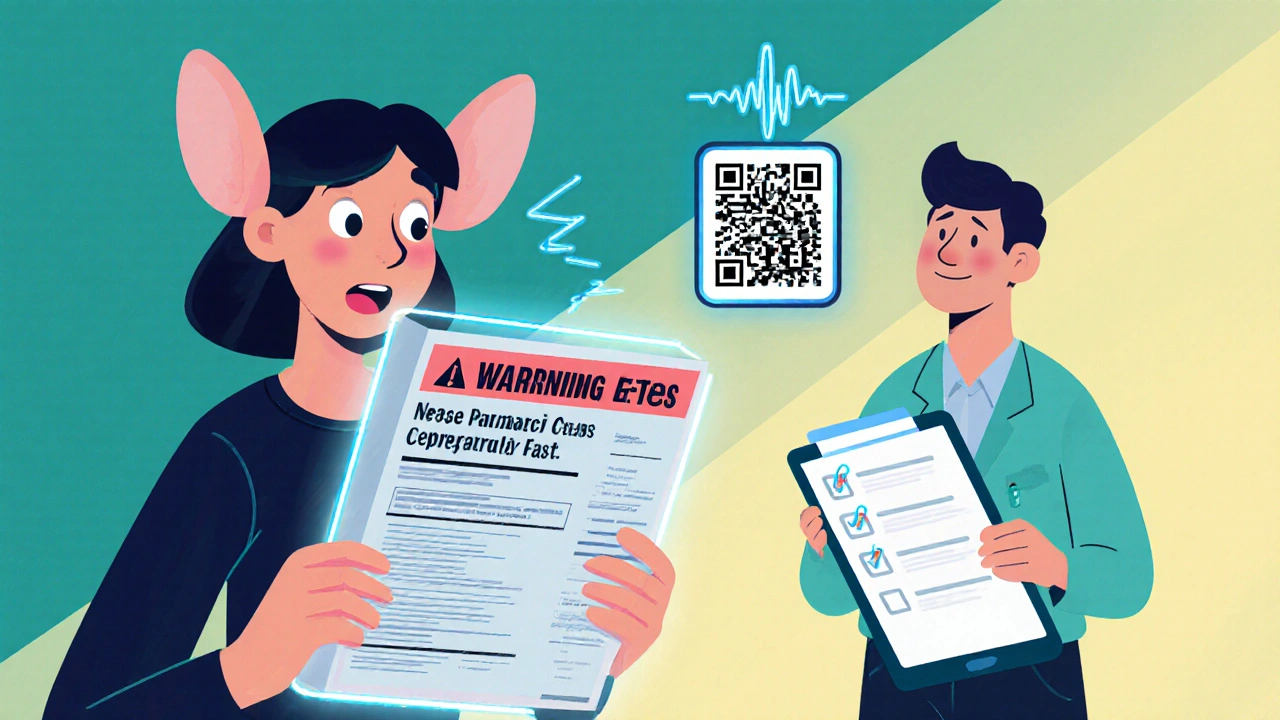
Emerging Tools and Future Trends
Digital innovation is trying to fill the knowledge gap left by the missing prescriber. QR codes on packaging now link directly to up‑to‑date interaction checkers. Walmart’s pilot in 2023 showed that customers who scanned the code were 27 % more likely to read the warning section.
The FDA’s draft guidance on Real‑World Evidence encourages manufacturers to collect post‑market safety data via mobile apps. In practice, you could report side effects directly from your phone, helping regulators spot patterns faster.
Looking ahead, AI‑driven recommendation engines may suggest the safest OTC options based on your electronic health record-provided you give explicit consent and your provider keeps the data current.
Quick Takeaways
- Rx-to-OTC switches increase access but shift safety responsibility to you.
- High‑risk groups-children, seniors, and polypharmacy patients-need extra caution.
- Always read the full "Drug Facts" label and verify warnings against your health conditions.
- Use the three‑step checklist: warnings, ingredient cross‑check, pharmacist consult.
- Leverage QR codes and mobile apps for real‑time safety updates.
Frequently Asked Questions
Can I take an OTC pain reliever if I’m already on a prescription NSAID?
No. Combining two NSAIDs (e.g., ibuprofen OTC plus a prescription naproxen) increases the risk of stomach bleeding, kidney injury, and heart problems. Stick to one NSAID at a time and ask your pharmacist for alternatives.
What should I do if I accidentally double‑dose acetaminophen?
Seek medical attention immediately. Even if you feel fine, acetaminophen toxicity can damage the liver within 24‑48 hours. Call Poison Control (1‑800‑222‑1222 in the U.S.) and have your medication list ready.
Are “behind‑the‑counter” products safer than regular OTC items?
They’re more regulated because sales require ID verification or a limit on quantity (e.g., pseudoephedrine). This reduces misuse, but you still need to read the label and consider interactions.
How can I tell if an OTC allergy medication will make me drowsy?
Check the "Uses" and "Warnings" sections for terms like “causes drowsiness” or “may impair mental alertness.” Second‑generation antihistamines (e.g., loratadine) are labeled as non‑sedating, while first‑generation ones (e.g., diphenhydramine) warn about sleepiness.
Is it okay to share my OTC cough syrup with a family member?
Only if the dosage, age limits, and ingredient list match the other person’s needs. Many cough syrups contain dextromethorphan, which can cause serious side effects when mixed with certain antidepressants.

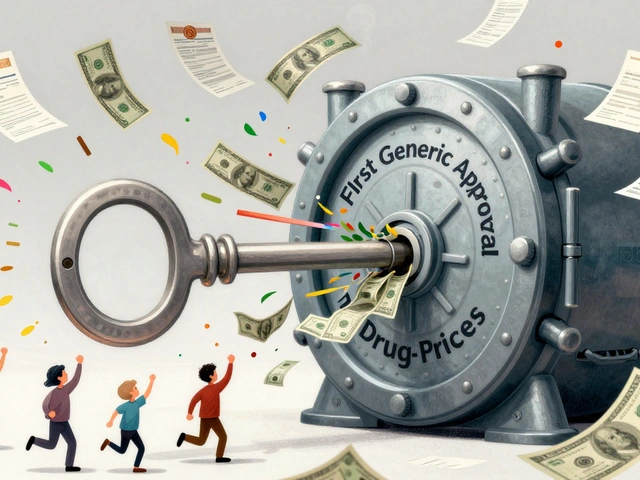
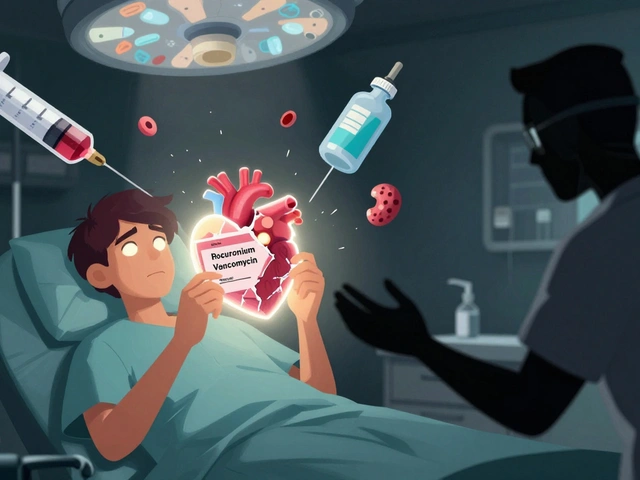
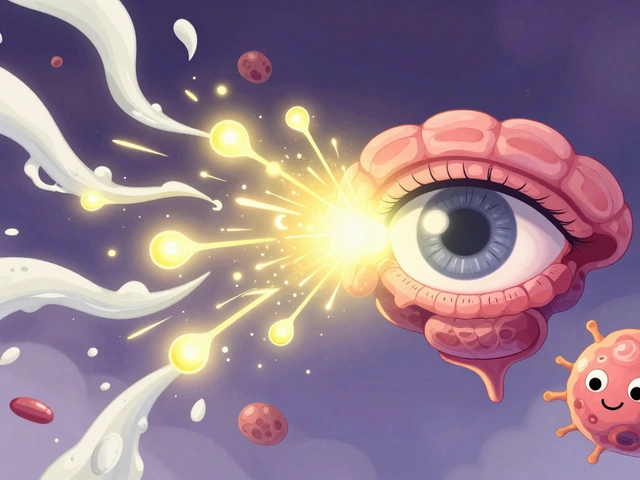

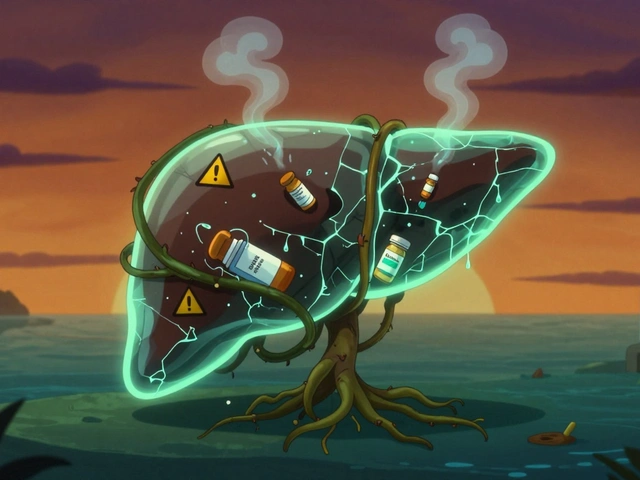
8 Comments
Thanks for laying out the basics; the three‑step checklist is spot‑on. I always start by scanning the "Warnings" before I even think about the active ingredient. Cross‑checking my prescription list on my phone saves me a lot of headaches, especially when I’m juggling blood‑pressure meds and occasional ibuprofen. A quick chat with the pharmacist can catch hidden interactions that the label might gloss over. Bottom line: a few minutes of attention now prevents a trip to the ER later.
/p>First, let’s acknowledge that the FDA’s decision to switch a drug from prescription to over‑the-counter is not a casual marketing move; it involves rigorous clinical data, real‑world usage studies, and a safety margin that can tolerate occasional misuse. However, the average consumer rarely reads the entire drug facts panel, and most rely on the front‑of‑pack claims that highlight “fast relief” without emphasizing the nuanced contraindications. One of the biggest pitfalls is self‑diagnosis-people treat a dull headache as a simple tension issue and reach for an NSAID, ignoring that the pain could be a symptom of an underlying aneurysm or infection that requires professional evaluation. Moreover, drug‑drug interactions are a silent killer; the active ingredient acetaminophen appears in countless cold remedies, prescription cough syrups, and even some multivitamins, creating a cumulative dose that can silently damage the liver over weeks. The elderly population is especially vulnerable because age‑related renal decline reduces the clearance of NSAIDs, increasing the risk of acute kidney injury even at recommended dosages. Children under twelve are frequently given adult‑strength formulations because the packaging looks similar, leading to accidental overdoses that can be fatal. Polypharmacy, or the use of multiple prescription medications, compounds the danger-adding an OTC antihistamine to a regimen that already includes a sedative can precipitate profound drowsiness and falls. The Beers Criteria from the American Geriatrics Society lists roughly thirty OTC products that are high‑risk for seniors, and clinicians often overlook these when reconciling medication lists. A practical way to mitigate these risks is to treat every OTC purchase as a mini‑consultation with yourself: read the warnings, compare active ingredients against your current meds, and, if you’re on three or more prescriptions, schedule a five‑minute check‑in with your pharmacist. Digital tools are emerging to assist-QR codes on the back of the label can link you to an up‑to‑date interaction checker that accounts for brand, dosage, and timing. Some pharmacies now integrate these scans with their dispensing software, flagging potential red flags before the product even leaves the shelf. Additionally, medication‑tracking apps can send alerts when you approach the maximum daily dose for a shared ingredient like acetaminophen. Finally, remember that the convenience of OTC does not absolve you of responsibility. The same regulatory safeguards that allowed the switch also assume a level of health literacy that many consumers simply do not possess. Investing a few minutes in education, whether through a pharmacist, a reputable website, or a trusted health app, pays dividends in safety and peace of mind.
/p>While the article sounds clean, you have to wonder who actually benefits from these “convenient” switches. The pharma giants push for over‑the‑counter status to sidestep prescription monitoring, letting them flood the market with drugs that are barely regulated. Even the FDA’s “real‑world evidence” program is a front‑run for crowdsourced surveillance that feeds data straight back to the manufacturers, not the public. Don’t be fooled by the QR code hype; it’s just another data point for Big Pharma’s profit engine.
/p>The label is a trap designed by Big Pharma.
/p>It’s absurd that we let market forces dictate what ends up in our medicine cabinets while ignoring the cultural erosion of informed consent. In a truly sovereign health system, access would be paired with rigorous education, not a laissez‑faire approach that treats citizens like test subjects.
/p>Yo, the three‑step hack is fire! 👊 Scan the warning, match the actives, then hit up the pharmacist-boom, you’re safe. No need to be a lab‑coat to dodge a nasty drug mix.
/p>Wow!!! This is sooo helpful;;;; I love the clear steps; read warnings!!!; cross‑check ingredients; ask the pharmacist!!!
/p>OMG, the trutth is out there!!
/p>When I grab a bottle i feel like i’m defying destiny, but the realllly hidden risks loom like a dark cloud over my kitchen cabinet!!!